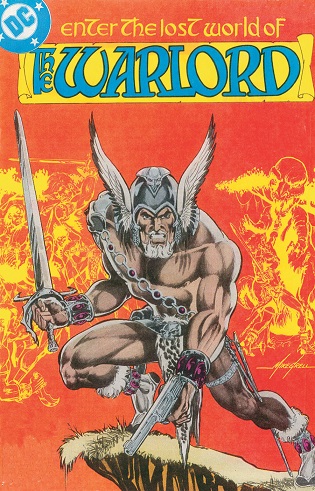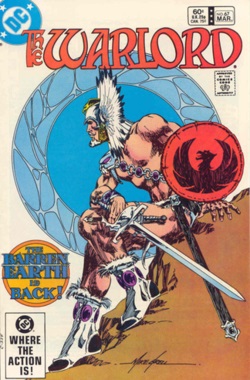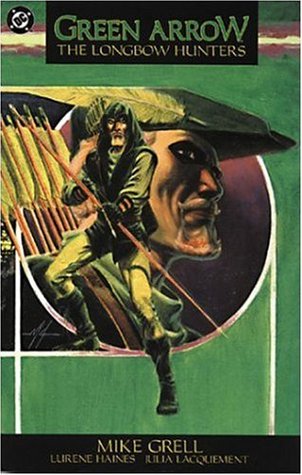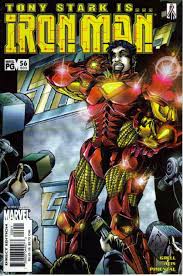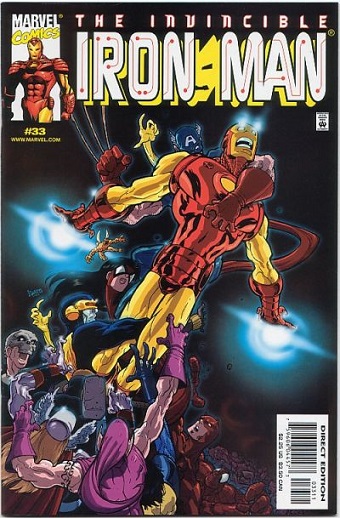As a comic creator, writer, and artist, Mike Grell has made incredible contributions to the comics industry over the past 40 years. His creation and work in the Warlord, Jon Sable Freelance, Green Arrow, and Iron Man, among others, has made him an indelible part of the industry. Recently, Scoop spent an afternoon talking with Grell about his career. He shared what he’s working on, what went into creating characters, who influenced him, and how he got into the industry. This is the first of a four-part interview that will run in Scoop.
Scoop: What are you currently working on?
Mike Grell (MG): Right as we speak I’ve got two graphic novel projects that I’m working on. One is in development, so I can’t really talk about that one. For the other one, I’m working on resurrecting Maggie the Cat. I’ve had a good deal of interest in her. I’ve written a screenplay, which is getting some pretty serious play. The character had only run two issues before the collapse of the industry in the ’90s took her out of circulation. I think it might be a good time to bring her back into the public eye.
Scoop: That sounds pretty exciting.
MG: Yeah, it’s a fun character. For background for anyone that doesn’t know, Maggie is former model who marries a British gentry, gentleman, so to speak, thinking that she’s going to have some sort of a Princess Grace kind of life. But, what she ends up with is really more like Princess Di, where her husband is a philandering no good SOB. He has squandered, literally squandered, the family jewels on gifts to all of his many mistresses prior to killing himself in a car wreck along with the latest conquest. He leaves Maggie penniless except for a ramshackle castle in Scotland and a curmudgeon Scot who is acting as her butler-confidante, Higgins to her Eliza Doolittle. He gets involved in training her to become the world’s greatest cat burglar. The idea is that she’s intent on stealing back all the jewelry her husband gave to all his mistress. But, along the way all of her activities come to the attention of the British intelligence and they press her into service to work with the SAS to ferret out a terrorist mastermind and bring him to justice. It’s a good old fashioned high-end adventure, action thriller in the vein of To Catch a Thief or, I suppose you could say like a female-type of James Bond. There’s all sorts of exotic locales and everything else and the character just she’s great because she’s smart, she’s sexy, and she’s got a great sense of humor. She’s a woman who is out to take back what’s hers come hell or high water.
Scoop: It sounds good. The capers like To Catch a Thief are great stories.
MG: I love caper films. I just really think when you set things up in an impossible situation and put your heroes into it and have them figure their way out by sheer cunning rather than brute force, that’s always the best.
Scoop: Would you say the tone of this will be more of a dramatic action or will there be elements of comedy to it?
MG: Everything I do has elements of comedy because I thoroughly believe that if you don’t have laughs to go along with the drama then you are wasting everybody’s time. Humor, well placed humor, can benefit just about every kind of genre you can imagine. Including horror-suspense.
My favorite example of that would be Silence of the Lambs. One of the creepiest, most disturbing films you’ve ever watched – you’d ever want to watch. And still, very handily done and well crafted because at the point where they manage to freak out the entire audience to the point where, I’m sure people would have been nervous about walking to their cars after the film, they sent everybody out with a big laugh. The closing of the movie? It’s where Hannibal Lecter is talking to Clarice Starling and says, “I’m having an old friend for dinner.” Everybody laughed and I watched people’s faces as they left the theater. Everybody was smiling, they were all chuckling, and they all went out with a positive experience. That could’ve been the other way around. They could just as easily have left you with that unsettling, uneasy feeling that would make you never, ever want to watch the movie again.
Scoop: That’s true, that bit of levity did make it more enjoyable. It’s a great movie.
MG: The other theory, with respect to well crafted humor and well placed humor, is that sometimes an audience, if there’s ever enough tension, they’ll laugh out of nervousness. If it’s a misplaced laugh you can destroy the entire moment you are trying establish. It’s better to take control yourself.
I had a line in a Sable novel that I wrote several years back – which we are going to be reprinting here, very shortly – I thought it was the funniest line I wrote in the entire book. It had to do with a situation where Sable is in Africa and he’s off on a culling mission removing unwanted Cape buffalo who are causing difficulties in one of the small villages. I had a line in there that said, “Standing in the middle of the Cape buffalo stampede is probably the most exciting thing you can do with your pants on.” I thought that line was hysterical, and it was a funny line, except that the editor said, “What else is going on in this moment? Do you really want the readers to be laughing?” I went, “Ah, okay, I get it.” Because while that scene was taking place I was intercutting with scenes of his home being attacked and his family being murdered. Sometimes you have to be judicious about where you put those laughs.
Scoop: Did you read comics when you were a kid?
MG: Of course. The first comics I read, my earliest memory about superhero comics, at any rate, was finding some old comics that my dad had in his footlocker when he came back from World War II. He had Captain America and Human Torch. I can’t remember what all was in there, but my brothers and I used to get a weekly allowance to buy a comic book. Back in those days it was a dime. My oldest brother went straight for the EC Comics with the ax through the head and blood and gore and horror and all that other stuff. It was great stuff. At that point I’m just about old enough to read a few words and look at the pictures. I got a big kick out of those. My middle brother was into cowboys and movie adaptation comics and things like that, along with a healthy smattering of humorous stuff.
I mostly leaned toward Donald Duck and Uncle Scrooge – things of that nature. We used to swap and trade among other kids, and I’m fairly sure I traded a hot copy of, I don’t know, Fantastic Four #1 for an equally hot copy of Archie or something like that. Back in the day we didn’t put any particular value on stuff. When I went off to college, of course I had the traditional box under my bed that had enough great, old Silver Age comics in it to at least make a pretty healthy down payment on a retirement. Of course, we also had newspaper comic strips and that was a big thing around the house. Every day when the paper would arrive when I was too young to read for myself my dad would read the comic strips for us.
Scoop: Did you guys save the comic strips?
MG: Yeah, I still have some. I have an original hanging on the wall here of Alley Oop that I gave my dad for his birthday one year. Dad had such a great voice for Alley Oop and he had the same sort of massive arms because he was a lumberjack and worked with a heavy chainsaw all day long. I used to picture dad as Alley Oop. He’d do all the voices and everything else. It was great. It’s perfect memories of the good old days, stuff that you don’t have anymore. We didn’t have television when I was a kid so we grew up with radio and movies, and comic books and comic strips.
Scoop: Who influences you as an artist and/or writer?
MG: There’s been a number of influences over my entire career. Earliest on, I really wanted to be the next Al Capp, I wanted to do Bigfoot funny sort of stories. I was on the path toward comic strips, but then when I was in the Air Force in Saigon in 1970 a fellow showed up who had a small collection of his favorite comics along with him. Among them was Green Lantern/Green Arrow by Denny O’Neil and Neal Adams and Dick Giordano, of course. That really set the tone for me.
I was strongly influenced by Neal Adams work early on because that was a wakeup call for me. You always have a soft spot in your heart for the one that really opened your eyes in the first place, and that is how I felt about that. I didn’t take very long to realize there was a lot more to it.
There’s books that I bought the same week and it was like an epiphany for me. I got one called The Magic Tale of Joseph Clement Coll who was an illustrator around the turn of the 20th century who worked on a lot of [Arthur] Conan Doyle books, including Lost World and he did King Solomon’s Mines, he’s a master and his lines are so exquisite. He could make a million shades out of just black and white. The combination of texture and line were just incredible.
The other one that I bought the same time was called The Pencil by Paul Calle. Calle did with a pencil what Coll did with a pen. As he did, he created texture and movement with just the lines that he was working with that had various shades of gray. It can be a bit of a challenge to create that depth and dimension that you’re looking for. What Calle did, that I really liked, was he used his pencil, not in terms of soft grays and graded tones but he used the pencil to create that same textured feeling of powerful strokes. I keep wanting to go back to the word texture. Strokes that were a combination of texture and direction that focus the eye. That really had a powerful effect on me because, at that point, I realized that if you’re careful in your penciling you didn’t necessarily have to ink your work. From that point on I started reproducing most of my work from my pencils instead of going to inks.
There are some genres that lend themselves better to pen and ink. When I do superhero stuff, like when I was doing Iron Man, I’d do colors or something like that, that has to do with a superhero, I just think that the combination of the dense blacks and the flexibility and fluidity of a flexible line you can get with a brush or pen lends itself better to the superhero genre. But when I’m doing something that’s action oriented or mystery oriented like the Sable books, most of Sable is reproduced from pencils, directly.
Scoop: How did you get into comics as a profession?
MG: Well, I really wanted to be a lumberjack just like my old man, but when I was 16 years old he got me a job working in the woods and as soon as I found out how hard that old boy had been working all those years. I realized there had to be an easier way to make a living.
So, I decided then that I’d become an architect and be the next Frank Lloyd Wright. Unfortunately, for me, or fortunately for the rest of the world, it turns out you have to be able to do something called math in order to be an architect. [laughs] Or you did back then. There were no cad programs and you couldn’t just put something in the computer and let the computer do the work, you had to be able to do it yourself. That pretty much blew me out of the water there.
So, then I settled on commercial art because it had the word “commercial” in it, which meant you get paid while you’re still alive instead of waiting until your dead to make all your money like Van Gogh. Never made a penny while he was alive, but now that he’s dead, he’s rolling in the dough. I’ve told everybody that as soon as I am dead I’m going to double all of my prices and cleanup.
So then I got caught up in the draft in the Vietnam War I decided that the Air Force was a better place to spend four years than the Army for two years in rice patties somewhere. While I was in basic training I met this guy who said, “Well, forget about being a commercial artist. What you really want to be is a cartoonist, because a cartoonist only works two or three days a week and he makes a million dollars a year.” And I said, “Where do I sign up?” That was it for me. I didn’t realize, of course, that he was talking about Charles Schulz, who’s certainly one of a kind. But, that’s what Schulz was doing. He’d work two or three days a week and he was making well over a million dollars a year. I think in that particular year he did, like, 13. I was impressed.
So, with that in mind I turned my focus to becoming a newspaper cartoonist. I had a couple of comic strips. One was called Iron Mike – a hard boiled private detective in the Mickey Spillane vein. Then it was called Savage Empire which was high action-adventure story about an archeologist who stumbles through a time warp and ends up in Atlantis before it sank.
I had dailies and six weeks of Sundays and a couple weeks of dailies and a line for the entire story in my bag when I went out to New York in ’73 to attend the New York Comic Con. The old Phil Seuling show back in the day. I found out that there was nobody interested in action-adventure comics at all. The genre was virtually dead. All they wanted was the next Peanuts. They wanted the guy that was actually making a million dollars a year, two or three days a week. I couldn’t deliver that.
While I was there, I met a couple of guys from DC Comics – Allan Asherman who had, at that time, been Joe Kubert’s editorial assistant, and Irv Novick, who was the Batman artist. Irv had seen me drop my portfolio off with Sol Harrison from DC Comics who was there reviewing portfolios at the time. I left my copy of Savage Empire with Sol and Irv grabbed me and asked if he could take a look at what I had in my bag and I showed him and he told me in no uncertain terms I should get my carcass up to Julie Schwartz’s office and show him what I had.
So I walked into Julie Schwartz’s office with my salesman spec that goes, “Good afternoon Mr. Schwartz, can I interest you in this deluxe 37-volume set Encyclopedia Britannica complete with annual yearbook and calendar?” And if you get interrupted anywhere along the line you have to go all the way back to “Good afternoon Mr. Schwartz.” That’s exactly how far I got – “Good afternoon Mr. Schwartz” and Julie says, “What the hell makes you think you can draw a comic?” I unzipped my portfolio, tossed it on his desk and said, “Take a look and you tell me.” He looked at my portfolio, called in Joe Orlando from the office next door, they put their heads together and I walked out a half hour later with my first script.
Look for the next installment when Grell talks about his experiences on Superboy and the Legion of Super-Heroes, Warlord, and Jon Sable Freelance.

















